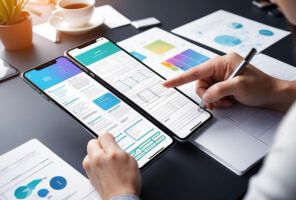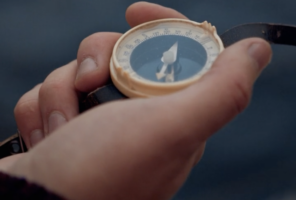Journey Toward the Business Value of Experience: Part 3
The CTO of one of our global clients recently praised the collaboration between his company and SPR’s UX and Product Design team: “We felt like one team working on this project together. SPR provided quick turnarounds on deliverables and communicated with us every step of the way. We asked SPR to simplify our platform and improve the user experience, and we received that and much more. We now have a global design system in place that enables us to scale our products and services over time. I'm getting value out of something I didn't even know I needed 12 months ago.”
So how did our client successfully modernize their experience? How did they get there and, more importantly, how can you get there?
Begin With a Vision
First and foremost, it's important to approach any modernization effort with support and vision from the executive leadership team. In lieu of this, or if you’re needing to rally and align leadership, you can strategically invest in a modest proof of concept to envision one or two of the most valuable use cases, demonstrate their potential impact, and build excitement around a shared vision that’s worth the full investment. In addition to leadership support, you need the right partners and right internal team members to champion the cause. These critical requirements are enough to warrant a separate blog post, but are worth mentioning here to emphasize their importance.
Create a Baseline
Assuming leadership support, teams, and partners are in place, start your modernization efforts by creating a baseline of your cumulative product experience. This makes sense for any business with a digital product and platform that’s been around for 5 to 20 or more years. Establishing a baseline gives the entire team a shared understanding of your current product experience with both qualitative and quantitative data. It also shines a light on areas of the product that are weak versus strong and helps sets the stage for tracking incremental product improvements and success over time. Establishing a baseline will also support your future efforts of product experimentation to stay ahead in the marketplace, as we’ll discuss later.
For example, when we began the project for the global client previously mentioned, in addition to going through the customer onboarding process, our team went through multiple product walkthroughs. We then performed a comprehensive product analysis, the results of which enabled us to align with key leaders and stakeholders on the areas and aspects of the product that were primed for modernization and optimization. With that alignment, we were able to prioritize the most valuable product modules the business wanted our team to focus on.
There are several ways to establish a baseline for the cumulative experience of your product, with varying levels of cost, time, and scope. Some of the best methods include usability testing or a product analysis and then using the outcomes of those exercises with a existing product data to create a baseline.
- Usability testing will provide you with detailed data on dysfunctional workflows, issues with global navigation, how well your product is meeting the changing behaviors, needs, and goals of your customers, as well as understanding the “why” behind current user behaviors. The size of your audience segments will depend upon the scope and cost of the investment, but even testing or evaluating a large global product can be done strategically and affordably.
- An extensive heuristic evaluation or UX/UI analysis can also be used to establish a baseline for the end-to-end user experience of your product. This method is both cost effective and quick, with the tradeoff being that you’re not establishing any type of baseline on observed user behaviors. However, you will create a baseline for how your product scores against global design standards, patterns, and best practices, as well as essential design principles.
Analyze the Findings
Taking the outcomes from these exercises and combining it with existing data from product tracking software, marketing data, customer service data, and any relevant qualitative and quantitative sources will help you create a more comprehensive picture and baseline of your overall product experience. From here, analyze the findings and conduct collaborative workshops to prioritize the key findings. The prioritization exercises help inform a holistic vision with near-term and long-term strategies to create a focus on incremental execution. It also forms a plan for systematically and programmatically modernizing your product experience to both increase and create new business value.
One of the key reasons our client has been so successful with the global modernization of their platform is because they used our partnership to learn how to start structuring and operationalizing a product and design team. During the time of our partnership, it was incredibly encouraging and beneficial for the project to have them actively hiring both product leadership and product owners to champion and work alongside their existing core product team.
Develop Your Team
A major component of realizing the business value of experiences and design is to develop a cross-functional team that unifies talent and expertise across practices. Silos are the way of the past and should be laid to rest. The first step on the path of having healthy DesignOps, DevOps and ultimately ExperienceOps is to begin identifying operational pain points. If you have no existing design team, it will add significant value to work with a partner as a part of any solution process so your organization can begin learning how to best model, hire, and operationalize a design team with a development team to quickly deliver valued products to market. Informed by your current state, collaboratively workshop with key internal stakeholders, as well as potential partners, to define value and desired outcomes for how you operationalize your product, design and development teams. Define tangible and realistic goals for structuring, hiring, and scaling your teams.
Tracking Your Performance
As we discussed in Part 2 of this series, Experience Performance needs to target and accommodate the C-Suite with senior leaders and include key metrics such as NPS, the System Usability Scale data, and additional standard product experience focused metrics.
But how do you get started on tracking the performance of your Product Experience?
We recently partnered with a global manufacturer to develop an enterprise metrics and KPI framework that tracks the ROI of one of their digital product experiences. This strategic framework focused on immediate and long-term needs in terms of metric measurement and prioritized a list of metrics and KPIs that aligned with their business objectives and goals.
At the beginning of the process, we assessed 8 of their analytics tools and provided guidance on feasible analytic tools to attach to their product then recommended the top 2 tool options that would best meet their specific needs. The project provided a set of agreed upon metrics and KPIs that are scalable to immediate and future-facing needs with a foundational and workable analytics strategy the client’s team can use for tracking, measuring, and proving value across their different product modules. We also provided specific guidance on the analytics tools that best aligned with the overall goal of demonstrating the impact and ROI of their digital product platform.
When you have your product modernization and product experience baseline established with cross-functional team operations and product performance all aligned, then you’ve established the key strategic pieces you need to begin realizing the business value of experiences. You’re now up and running and should be ready to take it one step further into creating ongoing product innovation for your organization.
One thing that makes product- and innovation-led companies so successful is the different growth levers they activate in the form of inquiring, acquiring, engaging, monetizing, and expanding the value they deliver to their customers. Being successful today requires companies to experiment more than their competition, which enables them to learn faster and grow quicker . One of your primary goals needs to be breaking free from organizational rigidity and only using what you need the most from the organization to drive growth experiments. Ongoing innovation can occur when your product-led growth levers provide a move away from complex architectures, ever-expanding microservices, and end-user guessing games where your teams waste time speculating about what users want. When your organization becomes empowered and mobilized and everyone gets on board with learning from experiments, your business will have more predictable wins with repeatable success at a significantly increased pace.
The goal with experiments is to start with a strong set of hypotheses and then create design prototypes for the potential solutions that you can then test with real end-users. The tests provide validation of value, uncovers the real opportunities and can speed up and reprioritize the product pipeline by eliminating low-value backlogged items. The PLG (Product-Led Growth) Experimentation framework we use at SPR is a fluid and flexible model that can align with your available resources without compromising the integrity of the approach.
Product-Led Growth Experimentation
Stage 1: Data That Informs
The initial stage of the experimentation framework ensures there’s enough data to inform a clear hypothesis, as well as alignment with desired business outcomes. Downsides and risks should always be considered upfront. We often hear clients say, “we don’t know what we don’t know,” so we will use this stage to understand what they do know and create an initial baseline from which we can launch into experimentation. Stage 1 ensures a proper framing and understanding of the problem space with the ability to prioritize a strong hypothesis or set of hypotheses, so the right resources from the cross-functional team can be coordinated to start running experiments.
Stage 2: Iterative Design
In Stage 2, you run iterative cycles of design prototyping, testing, and analyzing with users to validate or develop stronger hypotheses.
Stage 3: Alignment
During Stage 3, you nail down what’s important to your customers, align with key internal stakeholders and leadership, and start sizing and prioritizing the outcome from the experiment to determine which pieces require further design specification to be taken and built first.
Stage 4:Tracking Outcomes
Finally, in Stage 4, you track the business outcomes of those initial product builds and continue to engage users as you expand on the new trajectory with further experiments. Once the outcomes of the experimentation efforts have become solidified within the product, then those specific modules, features, and functions become a part of the ongoing incremental product improvements
As we close this series on the Business Value of Experiences, it’s important to remember to think about your efforts in terms small but strategic beginnings, incremental improvements, and new mindsets with coordination and communication across leadership and cross-functional teams.



